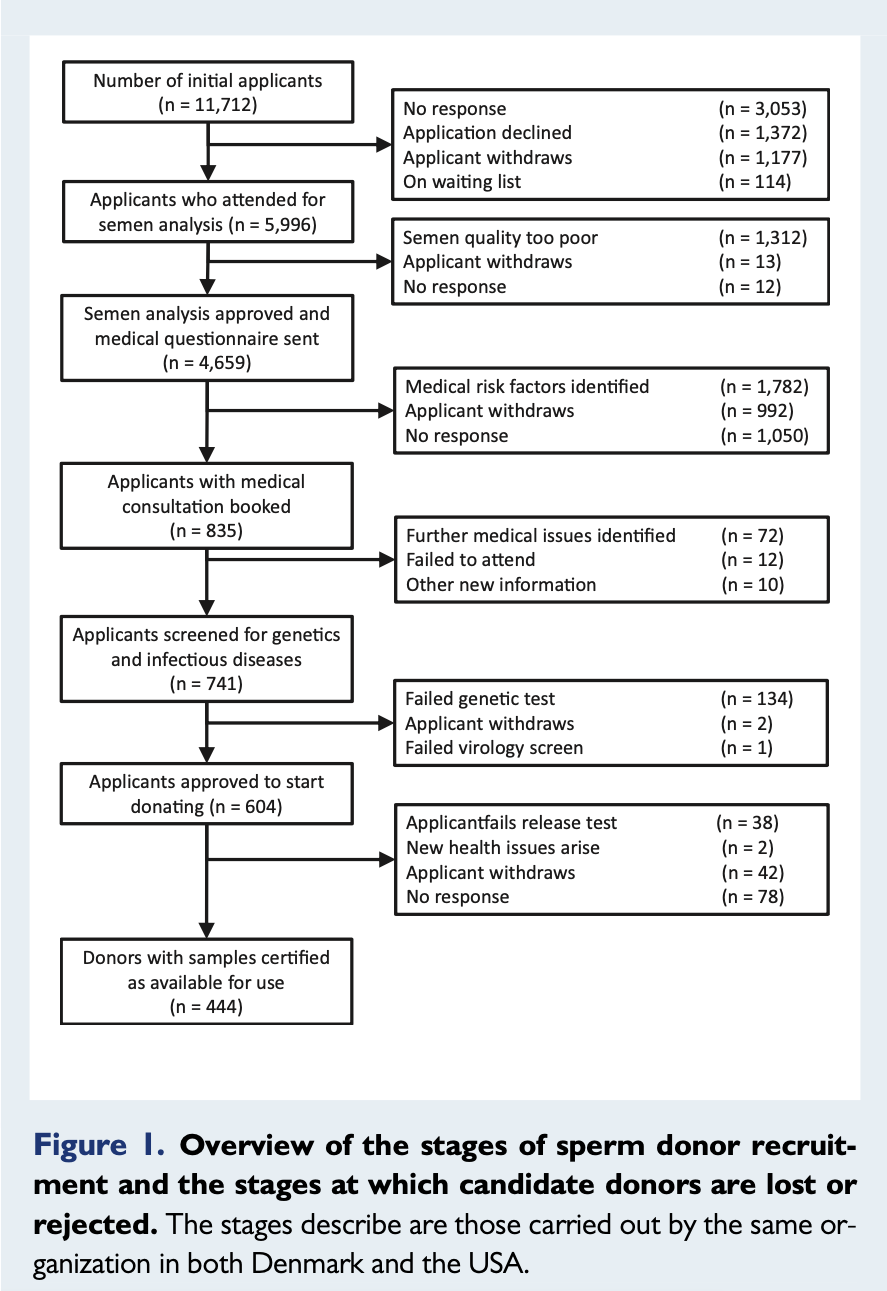Identity-release donors more likely to be accepted than anonymous donors in international screening study
An Analysis of the Outcome of 11,712 Men Applying to be Sperm Donors in Denmark and the USA (Pacey, 2023)
Pacey, A. A., Pennings, G., Mocanu, E., Rothmar, J., Pinborg, A., Adrian, S. W., Burke, C., & Skytte, A.-B. (2023). An analysis of the outcome of 11,712 men applying to be sperm donors in Denmark and the USA. Human Reproduction, 38(3), 352-358. https://doi.org/10.1093/humrep/deac264
Geographic Region: Denmark and USA
Research Question: Is the outcome of donor recruitment influenced by the country in which recruitment took place or the initial identity-release choice of applicants?
Design: This was a retrospective analysis of anonymized records from Cryos International, a commercial sperm bank operating in both Denmark and the USA. Data were collected from all sperm donor applicants during the calendar years 2018 and 2019, using identical recruitment processes and clinical protocols in both countries. The recruitment process began when potential donors completed an online application form, including their initial preference for identity-release or non-identity-release donation. Successful applicants then provided semen samples for quality assessment and cryopreservation testing. Those meeting this criterion received detailed medical questionnaires covering lifestyle, medical history, and family genetic history. Candidates were then invited for medical consultations, including psychological interviews, followed by blood and urine testing for infectious diseases and genetic screening. Statistical analysis was performed to examine differences between locations and donor identity-release preferences at each stage of the recruitment process.
Sample: A total of 11,712 men applied to be sperm donors during 2018 and 2019, with 5,878 applications from Denmark and 5,834 from the USA. At the time of application, 4,833 men chose identity-release donation, while 6,879 chose non-identity-release (i.e., anonymous) donation.
Key Findings
Only 3.79% of all applicants (444 out of 11,712) were ultimately accepted as donors and had samples certified for use in treatment. Denmark had statistically significantly higher acceptance rates than the USA (6.5% vs 1% respectively).
Identity-release donors were more likely to be accepted than non-identity-release donors (4.7% vs 3.2%). This finding was statistically significant.
The most common reasons for rejection were: withdrawal or non-response (55%), health issues or failed screening tests (18%), not meeting initial eligibility criteria (12%), and poor sperm quality (11%).
More applicants in the USA withdrew or failed to respond compared to Denmark (61% vs 49%). This finding was statistically significant.
In Denmark, most men who dropped out (95%) quit right after applying and never even came in for testing. In the USA, over half of the men who dropped out (56%) actually went through the initial sperm testing and only quit later when they received the detailed medical forms to fill out.
More candidates in the USA were rejected for health issues compared to Denmark (21% vs 14%). This finding was statistically significant.
More candidate donors who chose ID release (19%) were rejected because they reported a disqualifying health issue or failed a screening test compared to those who chose non-ID release (16%).
During the process, 19% of accepted donors changed their identity-release preference. More switched from non-identity release to identity release (27%) than the reverse (11%). This finding was statistically significant.
Limitations: The study did not examine applicant demographic data, and the observed country and identity-release differences could be attributed to variations in age, education, race/ethnicity, or lifestyle factors. The study only included data from one sperm bank organization, and donor recruitment procedures may differ in other locations, depending on local laws or guidelines; therefore, the results may not be generalizable to other facilities. The study did not determine specific reasons why more applicants withdrew in the USA compared to Denmark. The research did not examine the effects of implications counseling or psychoeducational sessions on donor decision-making, commitment, or understanding of donation implications, despite counseling being part of the standard screening process.
Applications: If identity-release options attract more committed donors, policymakers and gamete banks could consider mandating or incentivizing open-identity systems. Future studies should collect comprehensive demographic data, including age, race/ethnicity, education level, and socioeconomic status, to identify true predictors of donor recruitment success. Studies must examine whether current recruitment practices create disparities in donor availability across different racial, ethnic, and socioeconomic communities, and develop strategies to ensure equitable access to diverse donor options that reflect the diversity of intended parents.
Funding Source: The study received no external funding. All authors are either Cryos employees or members of the Cryos External Scientific Advisory Committee.
Lead Author: Allan Pacey is a Professor in the Department of Oncology and Metabolism at The Medical School, University of Sheffield, UK. He is a leading researcher in male fertility and andrology with extensive expertise in sperm biology and assisted reproduction. No personal connection to donor conception was identified.
Regulatory Context
Denmark has operated under an identity-release system since 1985, where all donors must agree to be identifiable to offspring at age 18. Only altruistic donations are allowed, with compensation for expenses. Same-sex couples and single women have had access since 2005-2016.
The United States has no comprehensive federal laws regulating gamete donation. The process is largely self-regulated by the fertility industry with FDA oversight for infectious disease screening. No legal limits exist on donor compensation, and anonymous donations are permitted. State laws vary widely regarding assisted reproduction and parentage.
Related Studies


